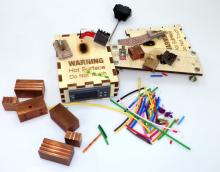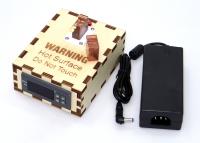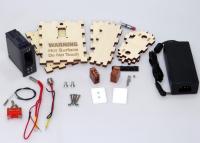Filament Splicer
Project cancelled, click here to read why
The idea for Filament Splicer was born about a month after our Ultimaker 3D Printer was build. As cool as 3D Printing is, printing in one color is boring.
Users of normal, single head FFF/FDM printers are stuck with single color unless they join filament pieces together to produce one multi-colored string. It is not very complicated but process is quite awkward and you will get fed up very quickly.
If you want to have proper, stable filament join you need to have right temperature on the tip of plastic when you connect pieces together. This is hard to achieve when you use some arbitrary heat source. You either underheat or overheat and burn the plastic. Using print head of your printer is best 'ad-hoc' solution but it leaves quite a mess on it, you cannot print when you splice and plastic which is in the head slowly gets burned while you take time to splice your string.
Then, of course there is issue with forming of the joint, carpet knife and fingers where our favorite tools for that job but it took quite a long time to form each joint.
We have had our share of failed prints due to broken joints / stuck filament and finally decided to create a device which will help to splice filament. Initial idea was to create fully automated unit: you place filament ends on copper block, close it, push the button and viola - you have your joint. That was the theory.... In practice this is impossible because PLA and ABS expand during heat-up and contract during cool down, this results in either no joint at all or bubble-filled mess.
Many headache filled days [Even best PLA is really nasty stuff when you breath it in for a while] later we dropped the idea and went for 'open' model with precisely manufactured grooves which help to quickly heat up, connect and form joints.
Thermal insulation was another challenge, we wanted to allow up to 260c temperature but nothing could properly insulate enclosure from hot copper block for prolonged period of time. Ceramic fiber thermal tape can take that heat but one needs a lot of it and then there is itching... Chinese tape is horrible and even best branded, made in USA [ThermoTec] tape is not flawless. We eventually gave up on ceramic fibre and went with PFTA [Teflon] plates. Since PFTA can be outright poisonous at high temperatures, we decided to use high quality - made in Europe material - this way we are sure that maximum temperature of 235c is well within safety limit.
Availability
Filament splicer can be pre-ordered via our campaign on Indiegogo, it is available as a DIY kit or fully assembled unit.
Open Source
Filament splicer blueprints are released under Creative Commons Attribution-NonCommercial 4.0 International License and can be downloaded from Thingiverse and Youmagine.





73201 Comments
All information about medicines. RPAH
buying generic ... (not verified)
onMon, 07/28/2025 - 02:05
Permalink
Drugs information. Short-Term Effects.
<a href="https://clomid4x365.top">buying generic clomid without prescription</a>
Some trends of pills. Read information now.
amoxicillin 500mg capsule buy online
RalphDyeld (not verified)
onMon, 07/28/2025 - 02:08
Permalink
can you get cheap clomid price: <a href=" https://clomidhubpharmacy.shop/# ">Clomid Hub</a> - can you get generic clomid online
Best information about meds. FQTG
how to buy vera... (not verified)
onMon, 07/28/2025 - 02:16
Permalink
Medication information leaflet. Effects of Drug Abuse.
<a href="https://verapamil1day.top/">how to buy verapamil without dr prescription</a>
Everything news about medication. Get information here.
prednisone 1 mg tablet
Brianreilk (not verified)
onMon, 07/28/2025 - 02:26
Permalink
gabapentin 100mg tablets picture: <a href=" http://neuroreliefrx.com/# ">NeuroRelief Rx</a> - gabapentin and anxiety depression
Everything information about medicine. LOXP
cost of cheap m... (not verified)
onMon, 07/28/2025 - 03:04
Permalink
Medicines information for patients. Generic Name.
<a href="https://motrin1day.top/">cost of cheap motrin no prescription</a>
Everything news about medicament. Get information now.
Купить букет роз
Matthewnor (not verified)
onMon, 07/28/2025 - 03:19
Permalink
Заказала розы для фото на аватарку - получились идеальные кадры!
<a href=https://superogorod.ucoz.org/forum/2-4050-1>белые розы купить томск</a>
continent sat Som
Michaelsix (not verified)
onMon, 07/28/2025 - 03:41
Permalink
<a href=https://continent-telecom.com>виртуальный мобильный номер телефона</a>
Actual trends of pills. UYNI
buy zanaflex (not verified)
onMon, 07/28/2025 - 04:04
Permalink
Medication prescribing information. Generic Name.
<a href="https://zanaflex1day.top/">buy zanaflex</a>
Everything what you want to know about meds. Read information now.
A sustainable model
Clintonbek (not verified)
onMon, 07/28/2025 - 04:23
Permalink
Unity and BrightBuilt factory-built homes share an important feature: They are airtight, part of what makes them 60% more efficient than a standard home. GO Logic says its homes are even more efficient, requiring very little energy to keep cool or warm.
[url=https://kra35c.cc]kraken даркнет[/url]
“Everybody wants to be able to build a house that’s going to take less to heat and cool,” said Unity director Mark Hertzler.
Home efficiency has other indirect benefits. The insulation and airtightness – aided by heat pumps and air exchangers – helps manage the movement of heat, air and moisture, which keeps fresh air circulating and mold growth at bay, according to Hertzler.
https://kra35c.cc
kraken
Buntel, a spring allergy sufferer, said his Somerville home’s air exchange has made a noticeable difference in the amount of pollen in the house. And customers have remarked on how quiet their homes are, due to their insulation.
“I’m from New England, so I’ve always lived in drafty, uncomfortable, older houses,” Buntel said. “This is really amazing to me, how consistent it is throughout the year.”
Some panelized home customers are choosing to build not just to reduce their carbon footprint, but because of the looming threat of a warming planet, and the stronger storms it brings.
Burton DeWilde, a Unity homeowner based in Vermont, wanted to build a home that could withstand increasing climate impacts like severe flooding.
“I think of myself as a preemptive climate refugee, which is maybe a loaded term, but I wasn’t willing to wait around for disaster to strike,” he told CNN.
Sustainability is one of Unity’s founding principles, and the company builds houses with the goal of being all-electric.
“We’re trying to eliminate fossil fuels and the need for fossil fuels,” Hertzler said.
Goodson may drill oil by day, but the only fossil fuel he uses at home is diesel to power the house battery if the sun doesn’t shine for days. Goodson estimated he burned just 30 gallons of diesel last winter – hundreds of gallons less than Maine homeowners who burn oil to stay warm.
“We have no power bill, no fuel bill, all the things that you would have in an on-grid house,” he said. “We pay for internet, and we pay property taxes, and that’s it.”
Best about medicine. KAQM
how can i get r... (not verified)
onMon, 07/28/2025 - 04:53
Permalink
Medicine prescribing information. Short-Term Effects.
<a href="https://rogaine1day.top/">how can i get rogaine price</a>
Everything about medication. Read information now.
Gim 5 Xylw Twf
where can i buy... (not verified)
onMon, 07/28/2025 - 04:56
Permalink
<a href="https://healthymedinfo.top/buy-rumalaya/">cost rumalaya without prescription</a>
Best trends of medicine. JXVN
tapering off 50... (not verified)
onMon, 07/28/2025 - 05:28
Permalink
Meds information sheet. What side effects can this medication cause?
<a href="https://trazodone365x.top">tapering off 50 mg of desyrel is not that difficult</a>
Best what you want to know about medicines. Get now.
Navigating the alt-meat landscape
DarrellLouse (not verified)
onMon, 07/28/2025 - 05:47
Permalink
While manufacturers continue to tweak their products to overcome the stigma of ultraprocessed foods, nutritionists suggest consumers move forward in choosing products that help the planet — as long as they keep reading the nutrition label.
“I would look for something with a good fat composition in which saturated fat is less than a third of the total fat,” Willett said. “Some vegetable burgers made from peas and legumes can be quite starchy, which the body breaks down similarly to sugar, so I would prefer to see alternatives with more healthy fat, more nuts, more soy.”
[url=https://tripskan.org]трипскан[/url]
While the Dietary Guidelines for Americans call for a limit of 2,300 milligrams of sodium per day for adults, “the American Heart Association recommends a limit of 1,500 milligrams for adults over 50, which is the standard I prefer,” Willett said.
“Look for about 1 milligram of sodium per calorie, which is a pretty good criteria,” he added. “In general, salt and saturated fat are the two really important factors — along with something that’s flavorful or delicious, which is, of course, up to the consumer.”
https://tripskan.org
tripscan top
One more key point from Willett: Before plant-based meats can truly help save the planet, they need to come down in price.
“These products are quite a bit more expensive, from what I’ve seen, than basic hamburger,” he said, “and we really need products that are price competitive with the beef and pork if we’re going to see them used on a daily basis, not just by people who can afford it.”
All what you want to know about drugs. EQGM
too much low do... (not verified)
onMon, 07/28/2025 - 05:53
Permalink
Medication prescribing information. Drug Class.
<a href="https://naltrexone24h.top/too-much-low-dose-naltrexone/">too much low dose naltrexone</a>
Some information about pills. Get information here.
Betwinner code
KennethJeono (not verified)
onMon, 07/28/2025 - 05:54
Permalink
Betwinner grants new users from Portuguese-speaking areas [url=https://www.imdb.com/list/ls4100835433/]https://www.imdb.com/list/ls4100...
Sharjah
Jerrydak (not verified)
onMon, 07/28/2025 - 05:55
Permalink
https://www.reddit.com/r/Sharjah/comments/1lzmzzh/has_anyone_leased_or_b...
?? h126w
MarquelWrisa (not verified)
onMon, 07/28/2025 - 06:03
Permalink
Браво, какая фраза..., блестящая мысль
??/????/??/?????????/??? ?? ??? ??? ??? ? ?? ?? [url=https://agentimmo225.com/index.php/2025/07/20/page-66/]https://agentimmo... ??|?? ???|?? ???|?? ???|?? ???/?? ???/?? ???/?? ???/?? ???/?? ???/?? ???/?? ???/?? ???/?? ???/?? ???/?? ???/?? ???/?? ???/?? ???/?? ???/?? ???/?? ???/?? ???/?? ???/?? ???/?? ???/?? ???/?? ???/?? ???/?? ???/?? ???/?? ???/?? ???/?? ???/?? ???/?? ???/?? ???/?? ???/?? ???
Bwin casino v514y
Ashleybew (not verified)
onMon, 07/28/2025 - 06:04
Permalink
?Que BQ el mas alto cuotas en [url=https://mairusa.com/testimonials/fedor-penchukov/]https://mairusa.com/te...? nosotros hace mucho tiempo interpretado que obtener una licencia juegos de azar, ofrecer eventos deportivos o una amplia gama de mercados son clave.
Porno
Josephfer (not verified)
onMon, 07/28/2025 - 06:06
Permalink
<a href=https://spinbetterguncel.com/>porno</a>
Sharjah
Jerrydak (not verified)
onMon, 07/28/2025 - 06:12
Permalink
https://www.reddit.com/r/Sharjah/comments/1lzmzzh/has_anyone_leased_or_b...
Betwinner code
KennethJeono (not verified)
onMon, 07/28/2025 - 06:13
Permalink
Betwinner grants new users from Portuguese-speaking areas [url=https://www.imdb.com/list/ls4105504087/]https://www.imdb.com/list/ls4105...
Best what you want to know about medicine. YVYU
can you buy che... (not verified)
onMon, 07/28/2025 - 06:13
Permalink
Medicament information. Short-Term Effects.
<a href="https://seroquel1x24.top">can you buy cheap seroquel</a>
Actual trends of medicines. Read now.
Sharjah
Jerrydak (not verified)
onMon, 07/28/2025 - 06:14
Permalink
https://www.reddit.com/r/Sharjah/comments/1lzmzzh/has_anyone_leased_or_b...
Betwinner code
KennethJeono (not verified)
onMon, 07/28/2025 - 06:15
Permalink
Betwinner grants new users from Portuguese-speaking areas [url=https://www.imdb.com/list/ls4105080352/]https://www.imdb.com/list/ls4105...
Sharjah
Jerrydak (not verified)
onMon, 07/28/2025 - 06:21
Permalink
https://www.reddit.com/r/Sharjah/comments/1lzmzzh/has_anyone_leased_or_b...
Betwinner code
KennethJeono (not verified)
onMon, 07/28/2025 - 06:22
Permalink
Betwinner grants new users from Portuguese-speaking areas [url=https://g-r-s.fr/pag/code_promo.html]https://g-r-s.fr/pag/code_promo.htm...
Some trends of medication. YGWZ
how to get gene... (not verified)
onMon, 07/28/2025 - 06:39
Permalink
Drugs prescribing information. What side effects can this medication cause?
<a href="https://glucophage4x365.top">how to get generic glucophage tablets</a>
Actual what you want to know about medicament. Get here.
кайтинг
Ramontunse (not verified)
onMon, 07/28/2025 - 07:02
Permalink
<a href=https://rutube.ru/shorts/cb44391727e39c55e798f4efcecadbbe/>кайт школа</a> Кайтсёрфинг оборудование должно соответствовать вашему уровню подготовки и условиям катания. Правильно подобранный кайт, доска и трапеция обеспечат вам комфорт и безопасность на воде.
Крайне рекомендую
JustinFus (not verified)
onMon, 07/28/2025 - 07:32
Permalink
<a href=https://graph.org/Complete-Guide-to-Free-Zones-06-19>https://graph.org/C...
Some news about meds. CLRR
how to buy gene... (not verified)
onMon, 07/28/2025 - 07:43
Permalink
Medication information leaflet. Short-Term Effects.
<a href="https://zoloft365x.top">how to buy generic zoloft pills</a>
Everything what you want to know about medicine. Get information here.
Everything information about meds. OFYR
where can i buy... (not verified)
onMon, 07/28/2025 - 07:48
Permalink
Medicament prescribing information. Effects of Drug Abuse.
<a href="https://cephalexin365x.top">where can i buy generic cephalexin for sale</a>
Best what you want to know about medication. Get now.
Sharjah
Jerrydak (not verified)
onMon, 07/28/2025 - 07:56
Permalink
https://www.reddit.com/r/Sharjah/comments/1lzmzzh/has_anyone_leased_or_b...
Блэкспрут ссылка
RichardBaide (not verified)
onMon, 07/28/2025 - 08:00
Permalink
<a href=https://itsteknosains.co.id>Mega онион</a>
amoxicillin from canada
DouglasZet (not verified)
onMon, 07/28/2025 - 08:20
Permalink
amoxicillin 500mg capsules antibiotic <a href=" https://bbs.hy2001.com/home.php?mod=space&uid=335676 ">purchase amoxicillin online without prescription</a> or <a href=" https://www.google.mu/url?q=https://clearmedsdirect.com ">amoxicillin without a prescription</a>
https://www.google.com.gt/url?q=https://clearmedsdirect.com amoxicillin 500mg
[url=https://cse.google.co.ck/url?sa=t&url=https://clearmedsdirect.com]where to buy amoxicillin 500mg[/url] order amoxicillin uk and [url=http://www.9kuan9.com/home.php?mod=space&uid=3742289]amoxicillin 500mg capsule[/url] amoxicillin over counter
Actual news about pills. VCPM
order generic a... (not verified)
onMon, 07/28/2025 - 08:36
Permalink
Medicament prescribing information. Effects of Drug Abuse.
<a href="https://actos1day.top/">order generic actos online</a>
Some information about meds. Get here.
Betwinner code
KennethJeono (not verified)
onMon, 07/28/2025 - 08:49
Permalink
Betwinner grants new users from Portuguese-speaking areas [url=https://www.imdb.com/list/ls4105506436/]https://www.imdb.com/list/ls4105...
Betwinner code
KennethJeono (not verified)
onMon, 07/28/2025 - 08:49
Permalink
Betwinner grants new users from Portuguese-speaking areas [url=https://www.imdb.com/list/ls4105505302/]https://www.imdb.com/list/ls4105...
Купить букет роз
Matthewnor (not verified)
onMon, 07/28/2025 - 09:15
Permalink
Заказал розы для предложения руки и сердца - она сказала "ДА"!
<a href=https://superogorod.ucoz.org/forum/2-4050-1>купить розы в томске</a>
Купить букет роз
Matthewnor (not verified)
onMon, 07/28/2025 - 09:17
Permalink
Букет из роз и гортензий - пышное великолепие, глаз не отвести!
<a href=https://severussnape.borda.ru/?1-1-0-00000217-000-0-0-1752486604>розы томскрозы в Томске</a>
Купить букет роз
Matthewnor (not verified)
onMon, 07/28/2025 - 09:20
Permalink
Белые розы в шляпной коробке - элегантность и роскошь! Получательница в восторге!
<a href=https://aktivnoe.forum24.ru/?1-9-0-00001227-000-0-0-1752486491>купить розы в томске</a>
Sharjah
Jerrydak (not verified)
onMon, 07/28/2025 - 09:25
Permalink
https://www.reddit.com/r/Sharjah/comments/1lzmzzh/has_anyone_leased_or_b...
Bfq 9 Mlab Tez
quels sont les ... (not verified)
onMon, 07/28/2025 - 09:35
Permalink
<a href="https://flagyl25store.shop">puis-je acheter de l'flagyl gГ©nГ©rique sans ordonnance</a>
Sharjah
Jerrydak (not verified)
onMon, 07/28/2025 - 09:37
Permalink
https://www.reddit.com/r/Sharjah/comments/1lzmzzh/has_anyone_leased_or_b...
Sharjah
Jerrydak (not verified)
onMon, 07/28/2025 - 09:41
Permalink
https://www.reddit.com/r/Sharjah/comments/1lzmzzh/has_anyone_leased_or_b...
Some trends of medication. NWQA
buying generic ... (not verified)
onMon, 07/28/2025 - 09:42
Permalink
Pills information. What side effects can this medication cause?
<a href="https://macrobid1day.top/">buying generic macrobid no prescription</a>
Best news about medication. Get information here.
amoxicillin 500mg capsules antibiotic
RalphDyeld (not verified)
onMon, 07/28/2025 - 09:47
Permalink
ReliefMeds USA: <a href=" https://reliefmedsusa.shop/# ">order corticosteroids without prescription</a> - anti-inflammatory steroids online
парфюмерия g924t
Ginacef (not verified)
onMon, 07/28/2025 - 09:48
Permalink
Жаль, что сейчас не могу высказаться - очень занят. Освобожусь - обязательно выскажу своё мнение.
к примеру, с сухих кожи быстро выветриваются любые ноты, [url=https://duhiguerlain.ru/]туалетная вода[/url] особенно дубовые и амбровые.
bigbasssplash-demo.online/ s471w
Aryalen (not verified)
onMon, 07/28/2025 - 09:50
Permalink
Бесподобная тема, мне очень интересно :)
Скаттер - тот самый большой окунь, в честь которого назван слот - дает от десяток бесплатных спинов, [url=https://bigbasssplash-demo.online/]bigbasssplash-demo.online/[/url] если похожих символов выпадет по крайней мере три (количество фриспинов зависит от количества скаттеров).
where can i buy clomid without prescription
Jamescof (not verified)
onMon, 07/28/2025 - 09:54
Permalink
wakefulness medication online no Rx [url=https://wakemedsrx.shop/#]buy Modafinil online USA[/url] WakeMedsRX
Блэкспрут ссылка
RichardBaide (not verified)
onMon, 07/28/2025 - 10:00
Permalink
<a href=https://itsteknosains.co.id>Мега сайт</a>
Pages
Add your comment